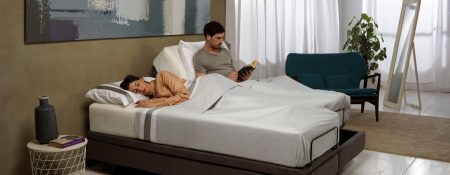You have floor-to-ceiling picture windows. You love the view and the fact that they allow immense amounts of natural light into your space. However, when it gets dark and the lights are turned on, the inside of your house becomes the view — and you don’t want that. It also gets awfully warm in the daytime, especially in a place like Dubai.
So, you get some curtain fabric made into window treatments to cover up your windows. Now, you must decide on your curtain style.
If you’re looking for privacy and heat control, choosing the right curtains in Dubai is an absolute must!
This article discusses the different types of curtain and drape headings. Before all that, though, it also answers the question: Why use drapes and curtains?
Most people use curtains and drapes interchangeably. They are both forms of window coverings or window treatments made of fabric panels.
However, curtains are generally short, extending just a few centimeters below the window. Drapes, meanwhile, are cut to floor length or even longer, in which case the extra fabric creates a fabric puddle on the floor. Drapes are also often thicker than curtains.
Regardless of their minor differences, curtains and drapes are more than just window dressing and offer many benefits.
Curtains and drapes contribute significantly to a room’s visual harmony, coordinating with furniture and decor to create a unified interior design.
Use sheer white, cream or beige curtains on bay windows for neutral airiness. You can also use high-sheen metallic weave drapes to pick up the gleam of your contemporary marble dining table and the patina of your gilded sofa.
Aside from serving as window coverings, curtains and drapes provide privacy, partition spaces, hide less appealing wall areas, and even function as a creative backdrop.
When hung correctly, curtains and drapes can make a room look bigger. You can hang curtains that extend wall-to-wall to create the illusion of bigger windows and wider space. Meanwhile, you can use ceiling-to-floor drapes to draw the eyes vertically and provide the illusion of high ceilings.
Control over sunlight is a key advantage, with thicker fabrics offering near-total blockage and lighter ones allowing a soft, diffused light.
Privacy, though, doesn’t have to mean compromising your view of the scenery outside. With curtains and drapes, you can have both. You can use sheer curtains with thick drapes to provide variable privacy options.
Curtains and drapes also provide window insulation, helping maintain low indoor temperature and potentially reducing energy bills.
Noise reduction is another plus, especially with the heavier fabrics of drapes. Some curtains even trap dust, contributing to a cleaner living environment.
Curtains and drapes are an integral part of a room’s personality. When choosing the type of curtains and drapes, consider the purpose and decor in a space.
The following are some of your curtain style options.
Note: For simplicity, the term “curtains” refers to both curtains and drapes moving forward. It’s entirely up to you if you want window treatments that are thicker (drapes) or flimsier (curtains).
A choice for the traditional at heart, pinch pleat curtains have evenly spaced pinched gatherings at the top, thus the “pinch pleat” name. There are different types of pinch pleating: single, duo, triple, four-finger, and five-finger. The higher the number, the more pleats a curtain has.
Pinch pleat curtains lend themselves well to formal and elegant settings. Pair them with fabrics like silk or velvet in a rich deep color for a luxurious look. They’re perfect for dining rooms or classic drawing rooms.
With their meticulously spaced pleats, tailored pleat curtains present a crisp appearance. They look similar to pinch pleat curtains, but these two types of curtains are not identical.
Tailored pleat curtains are pinched at the very top and the pleat falls immediately from there. Meanwhile, pinch pleat curtains have a pinched gathering that extends from the very top to about a few centimeters down, and only then do the pleats start.
Ideal for modern interiors, tailored pleat curtains in neutral colors work well with lighter materials and fit beautifully in fresh, modern spaces. You’ll find them easy to dress up or down, and you can pair them with contemporary art pieces or minimalist furniture.
For a sleek and elegant feel, consider inverted and box pleat curtains.
Inverted pleats are formed by gathering two folded edges toward their center until their edges line up. This fold creates a crease on the backside of the curtain.
Put the pleats in front, facing in, and you get a box pleat curtain.
Inverted and box pleat curtains go well with a minimalist interior design. Keep your color palette monochrome and accessories simple to accentuate their sleek lines.
Pencil pleat curtains have tightly packed, thin pleats on top. They are versatile, but they go exceptionally well in casual settings.
For a cozy feel, match them with warm-toned upholstery and wooden furniture.
Ideal for elevating and adding a touch of grandeur to any room, goblet curtains are named for the wine glass or goblet-like shape at the top of each pleat. These goblet shapes are filled with wadding to maintain their volume.
Goblet pleat curtains are especially well-suited for traditional homes with high ceilings. Their unique design can become a focal point in a grand living room or stately dining area.
Ripple fold curtains stand out for their gentle, continuous wave pattern. These are fantastic for rooms where you want a relaxed and calming atmosphere.
Consider pairing them with soft lighting and natural materials like rattan or wood. With an easy gliding mechanism, they’re user-friendly and suit spaces like family rooms and bedrooms where delicate aesthetics are preferred.
Simplicity is the hallmark of rod loop curtains. The fabric loops directly over the rod, providing an uncomplicated and casual look.
They’re excellent for laid-back spaces, such as a sunroom or casual dining area. Easy to install, they’re a go-to for those who prefer an unfussy appearance. Match them with comfy sofas, textured cushions, and laid-back art pieces.
With metal rings at the top, grommet eyelet curtains are a modern favorite. Their smooth glide makes opening and closing a breeze, and their clean lines suit contemporary homes.
Curtains in Dubai are more than window coverings.
By considering the overall theme and your personal preferences, you can use them to create spaces that are both visually pleasing and uniquely yours.
Whether you want it to give a bold statement or serve as a subtle complement, the right curtains and drapes can help transform your room.
Happy decorating!



